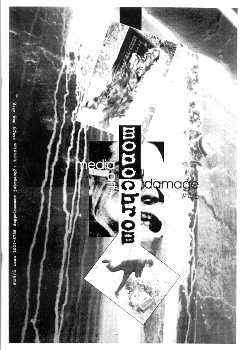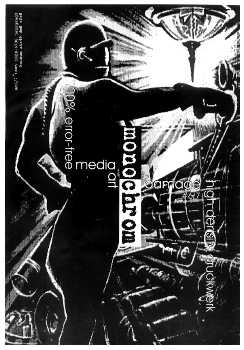monochrom, 3-10 (1994-1998) [German]
Filed under magazine | Tags: · art, conspiracy, copyleft, copyright, media, media art, media culture, net culture, philosophy, politics, science fiction, software, subversion, surveillance, tactical media, technology




The mouthpiece of an international art-technology-philosophy collective founded in 1993, with its headquarters at Museumsquartier in Vienna.
Editor-in-chief: Johannes Grenzfurthner
Publisher Monochrom, Vienna
ISSN 1024-6738
Authors
Monochrom on Wikipedia
PDF (No. 3: media dings, 1994/95, 68 pp)
PDF (No. 4-5: media art damage, 1995/96, 104 pp)
PDF (No. 6-7: 100% error free high-density druckwerk, 1997, 112 pp)
PDF (No. 8-10: gebenedeit unter den illustrierten, 1998, 180 pp)
Alexander R. Galloway: The Interface Effect (2012)
Filed under book | Tags: · aesthetics, computing, ideology, interface, media, media theory, mediation, ontology, philosophy, politics, software

“Interfaces are back, or perhaps they never left. The familiar Socratic conceit from the Phaedrus, of communication as the process of writing directly on the soul of the other, has returned to center stage in today’s discussions of culture and media. Indeed Western thought has long construed media as a grand choice between two kinds of interfaces. Following the optimistic path, media seamlessly interface self and other in a transparent and immediate connection. But, following the pessimistic path, media are the obstacles to direct communion, disintegrating self and other into misunderstanding and contradiction. In other words, media interfaces are either clear or complicated, either beautiful or deceptive, either already known or endlessly interpretable.
Recognizing the limits of either path, Galloway charts an alternative course by considering the interface as an autonomous zone of aesthetic activity, guided by its own logic and its own ends: the interface effect. Rather than praising user-friendly interfaces that work well, or castigating those that work poorly, this book considers the unworkable nature of all interfaces, from windows and doors to screens and keyboards. Considered allegorically, such thresholds do not so much tell the story of their own operations but beckon outward into the realm of social and political life, and in so doing ask a question to which the political interpretation of interfaces is the only coherent answer.
Grounded in philosophy and cultural theory and driven by close readings of video games, software, television, painting, and other images, Galloway seeks to explain the logic of digital culture through an analysis of its most emblematic and ubiquitous manifestation – the interface.”
Publisher Polity, 2012
ISBN 0745662528, 9780745662527
170 pages
Review: McKenzie Wark (Public Seminar, 2015).
PDF (updated on 2021-12-16)
Comments (3)Éric Alliez, Andrew Goffey (eds.): Guattari Effect (2011)
Filed under book | Tags: · aesthetics, anthropology, deterritorialization, ecology, economics, linguistics, media, media theory, philosophy, politics, psychoanalysis, sociology

“The Guattari Effect brings together internationally renowned experts on the work of the French psychoanalyst, philosopher and political activist Félix Guattari with philosophers, psychoanalysts, sociologists, anthropologists and artists who have been influenced by Guattari’s thought.
Best known for his collaborative work with Gilles Deleuze, Guattari’s own writings are still a relatively unmined resource in continental philosophy. Many of his books have not yet been translated into English. Yet his influence has been considerable and far-reaching. This book explores the full spectrum of Guattari’s work, reassessing its contemporary significance and giving due weight to his highly innovative contributions to a variety of fields, including linguistics, economics, pragmatics, ecology, aesthetics and media theory. Readers grappling with the ideas of contemporary continental philosophers such as Badiou, Žižek and Rancière will at last be able to see Guattari as the ‘extraordinary philosopher’ Deleuze claimed him to be, with his distinctive radical ideas about the epoch of global ‘deterritorialization’ we live in today, forged within the practical contexts of revolutionary politics and the materialist critique of psychoanalysis.”
Publisher Continuum, 2011
ISBN 1441121978, 9781441121974
224 pages
PDF (updated on 2012-7-15)
Academia.edu (added on 2016-3-11)

